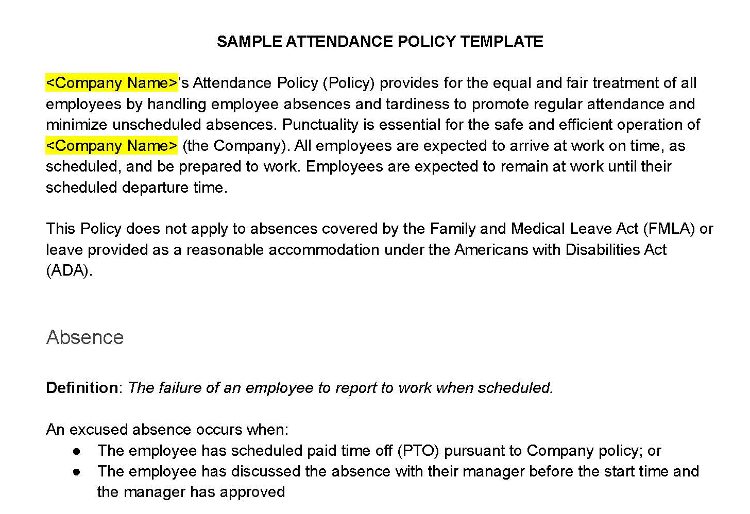Employee attendance policies are company documents, often part of your handbook, that clearly define attendance requirements at your company. These should include definitions, indicate how employees may be disciplined for violations of the policy, and an employee acknowledgement.
For an example of how to draft yours, download our free attendance policy template and customize it based on your business’s needs.

Thank you for downloading!
Bambee can assist you with all your policy needs with customizable templates.
Sections to Include in an Employee Attendance Policy
When creating employee attendance policies, it’s important to define the terms at the beginning of each section. This will help ensure everyone agrees to it and that there’s no ambiguity about what these terms mean. Ambiguity leads to confusion, which can leave employees frustrated and unsure of when they violate a policy.
To make sure you have an effective, fair, and legally compliant attendance policy, here are the most important sections to include.
Creating a structured and clear attendance policy is part of employee management. By setting proper expectations for attendance, arriving on time, and the disciplinary measures for failing to meet those requirements, you can properly instill discipline and a healthy respect for your company in your employees.
Tips for Creating a Fair Attendance Policy
You know the big pieces of your employee attendance policy—but now you want to ensure it’s fair. The best way to approach this is to customize it to your specific business needs and culture.
Here are some tips to consider to ensure that your policy is fair for everyone:
- Train Managers – For an easy time setting expectations and creating a fair setup of your attendance guidelines for employees, we recommend talking to and training your managers and supervisors. This is key to making sure employees receive equal treatment and that your company avoids legal headaches.
- Set Reasonable Expectations – Sometimes a violation of the attendance policy may be unavoidable. Having reasonable expectations and a clearly outlined attendance policy shows your team that you understand that sometimes, life gets in the way, and, when it does, they won’t suffer serious job-related consequences.
- Ensure Compliance – There are many areas of employment law you need to pay attention to when creating an attendance policy, including the difference between employee classifications.
- Nonexempt Employees – Usually hourly employees, they must receive overtime pay for any hours worked over 40 in a single workweek. You must pay them at least the current federal minimum wage of $7.25 per hour and time and a half for overtime.
- Exempt Employees – To qualify as exempt, employees must meet certain criteria, like having specific job duties and making a salary of at least $684 per week. You can find all the requirements in the Department of Labor (DOL) Fact Sheet #17A.
Ensuring compliance with the law can be difficult without structured procedures. When it comes to time tracking, make sure you have a proper process for tracking your employees hours in place.
Ways to Improve Employee Attendance
By implementing flexible scheduling options, fostering a positive workplace culture, and setting clear expectations, you can improve employee attendance rates significantly. These strategies not only benefit individual employees but also contribute positively toward overall productivity levels within the business.
- Implement a flexible work schedule – Offering employees the option to work remotely, adjust their start and end times, or even compress their working week can result in higher attendance rates. Download our flexible schedule policy template for some tips on how to implement this in your company.
- Create a positive work environment – When employees feel valued and supported, they are more likely to show up consistently and be engaged in their work.
- Openly communicate – Encourage open communication by recognizing achievements, offering opportunities for growth and development, and fostering a sense of camaraderie among team members.
- Offer ample paid time off – Most companies have some sort of paid time off for employees, a variation of holidays, vacation, and sick time. By offering your employees enough time off they will likely not have any attendance issues.
- Set clear expectations and accountability measures – By having an attendance policy you can outline your expectations of employees and the measures that will be taken should they violate the policy.
Check out our guide to managing employee attendance issues for more practical strategies and effective techniques that will help you create a more reliable workforce and boost productivity.
Did You Know? According to a Work in America survey, over half of employees (57%) experience negative impacts due to workplace stress. This stress could lead to an overall decline in attendance. By focusing on providing a fair and conducive environment for work, you can minimize attendance issues significantly.
Bottom Line
You expect employees to show up on time. When they don’t, that creates problems for the business and other employees. Emergencies happen, and companies should be flexible—but within reason. Having a clear attendance policy will help you hold employees accountable for their actions while treating everyone fairly and avoiding costly employee lawsuits and government fines.